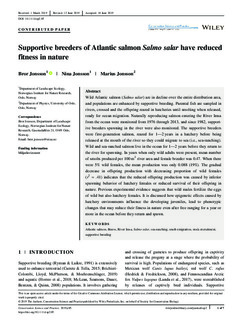Supportive breeders of Atlantic salmon Salmo salar have reduced fitness in nature
Peer reviewed, Journal article

Åpne
Permanent lenke
http://hdl.handle.net/11250/2603080Utgivelsesdato
2019Metadata
Vis full innførselSamlinger
- Scientific publications [1392]
Originalversjon
10.1111/csp2.85Sammendrag
Wild Atlantic salmon (Salmo salar) are in decline over the entire distribution area,
and populations are enhanced by supportive breeding. Parental fish are sampled in
rivers, crossed and the offspring reared in hatcheries until smolting when released,
ready for ocean migration. Naturally reproducing salmon entering the River Imsa
from the ocean were monitored from 1976 through 2013, and since 1982, supportive
breeders spawning in the river were also monitored. The supportive breeders
were first-generation salmon, reared for 1—2 years in a hatchery before being
released at the mouth of the river so they could migrate to sea (i.e., sea-ranching).
Wild and sea-ranched salmon live in the ocean for 1—2 years before they return to
the river for spawning. In years when only wild adults were present, mean number
of smolts produced per 100 m2 river area and female breeder was 0.47. When there
were 5% wild females, the mean production was only 0.088 (19%). The gradual
decrease in offspring production with decreasing proportion of wild females
(r2 = .41) indicates that the reduced offspring production was caused by inferior
spawning behavior of hatchery females or reduced survival of their offspring in
nature. Previous experimental evidence suggests that wild males fertilize the eggs
of wild but also hatchery females. It is discussed how epigenetic effects caused by
hatchery environments influence the developing juveniles, lead to phenotypic
changes that may reduce their fitness in nature even after free ranging for a year or
more in the ocean before they return and spawn.
